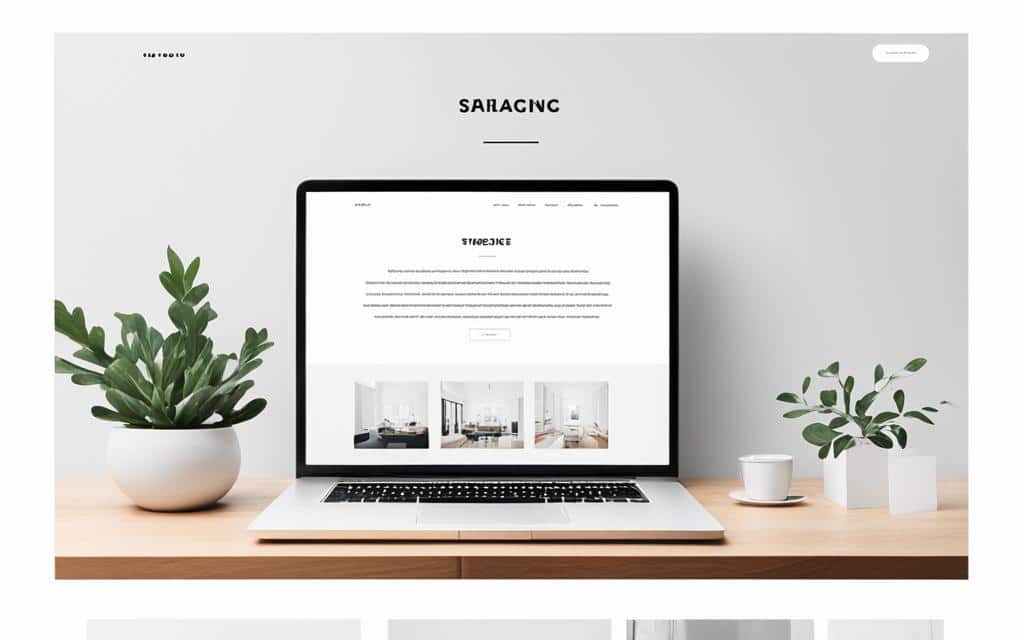Table of Contents
White space web design, also known as negative space, is a strategic element that can greatly influence the overall appearance and impact of a website. By strategically incorporating white space, designers can create a cleaner layout that enhances readability and user experience.
The concept of white space refers to the empty areas between elements on a web page. It can be categorized into two types: micro and macro white space. Micro white space refers to the small spaces between letters and lines of text, while macro white space refers to the larger spaces between major layout elements like images and text blocks.
White space is crucial in web design for several reasons. Firstly, it improves readability and content prioritization by breaking up blocks of text and images. Secondly, it creates a sense of elegance and sophistication, making a website appear clean and uncluttered. Lastly, the strategic use of white space enhances readability and comprehension, allowing the content to breathe and the message to be effectively absorbed.
The impact of white space on user experience is significant. By enhancing readability, white space provides visual breathing room, creating balance and harmony in the design. It also guides user navigation by strategically directing the user’s attention and creating a seamless flow.
To effectively use white space in web design, it is essential to understand the types of white space and how to leverage them. White space can be utilized to highlight call to action buttons, creating emphasis and guiding user interaction. Balancing white space and elements ensures that each component has enough room to stand out while maintaining a cohesive design.
There are common misconceptions about white space that need to be addressed. It is often viewed as wasted space when, in reality, it serves a crucial purpose in design. White space is not merely about aesthetics; it plays a significant role in usability and readability. Additionally, the misconception that more content is better than more white space overlooks the fact that white space helps break up content and improve navigation.
White space, far from being a mere backdrop, is a powerful design element that can transform a website from good to great. It enhances readability and user experience, creates balance and harmony, and improves the legibility and readability of content. Understanding and effectively using white space can significantly enhance the overall aesthetic appeal of a website. So, embrace the power of white space and leverage it in your web design for maximum impact.
Understanding the Concept of White Space
White space, also known as negative space, refers to the empty areas between elements on a page. It is a fundamental design element in web design that greatly impacts the overall user experience. By strategically utilizing white space, designers can create a cleaner and more visually appealing layout.
White space can be categorized into two types: micro and macro. Micro white space refers to the small spaces between smaller elements such as letters and lines of text. This type of white space ensures legibility and prevents overcrowding, allowing users to read the content more comfortably.
Macro white space, on the other hand, refers to the larger spaces between major layout elements like images and text blocks. It serves as a visual separator, guiding users’ eyes and providing a sense of organization on the page.
Understanding these types of white space is essential for effective web design. By strategically incorporating micro and macro white space, designers can create a well-balanced layout that enhances the user experience and directs users’ attention to the most important elements on the page.
Take a look at the visual representation below to better understand the concept of white space:
| Micro White Space | Macro White Space |
|---|---|
| Small spaces between letters and lines of text | Larger spaces between major layout elements |
| Improves legibility and readability | Creates visual separation and organization |
| Prevents overcrowding | Guides users’ eyes and attention |
To summarize, white space is an essential design element that allows for a cleaner and more organized web layout. By understanding the concept of white space and utilizing micro and macro white space effectively, designers can create visually appealing and user-friendly websites.
Why White Space is Important in Web Design
White space is of utmost importance in web design as it serves multiple crucial purposes. Firstly, it greatly enhances readability and content prioritization by effectively breaking up blocks of text and images. By providing visual breathing room between elements, white space prevents information overload and allows users to digest the content more easily.
Moreover, white space adds a touch of elegance and sophistication to a website, contributing to its overall aesthetic appeal. When used strategically, it creates a clean and uncluttered layout that exudes a sense of professionalism and refinement. A well-designed website with ample white space appears visually pleasing and can help establish a positive brand image.
Furthermore, the strategic use of white space greatly improves readability and comprehension, allowing the message to be effectively absorbed by users. By giving the content room to breathe, white space enhances legibility and ensures that key information and important elements stand out. It helps guide the eye and draw attention to crucial sections, ultimately leading to a more engaging user experience.
When implemented correctly, white space plays a significant role in optimizing the overall user experience. It allows for a balanced and harmonious design by creating a sense of order and structure. Additionally, it improves the functionality of a website by providing clear demarcation between different elements and sections.
“White space is like air: it is necessary for the reader’s comprehension. It allows your eyes to rest and creates a more enjoyable reading experience.” – Steve Jobs
The strategic use of white space can transform a website from average to exceptional, enhancing its visual appeal, readability, and user experience. By using white space effectively, designers can prioritize content, guide user attention, and create a sophisticated and elegant online presence. Embracing the power of white space is a crucial element of successful web design.
The Impact of White Space on User Experience
White space is not just an empty void on a webpage. It has a profound impact on user experience, enhancing readability, creating balance, and promoting harmony in web design. By strategically leveraging white space, designers can transform a website’s aesthetic appeal and improve overall user satisfaction.
One of the key benefits of white space is its ability to enhance readability. By breaking up content into manageable sections, white space allows users to navigate through information more easily. It provides visual breathing room, reducing cognitive load and making it simpler for users to focus on the content that matters most.
In addition to readability, white space contributes to creating balance and harmony in a design. It allows elements to breathe and prevents overcrowding, resulting in a clean and polished appearance. By judiciously incorporating white space, designers can achieve a sense of elegance and sophistication that captivates users and enhances their perception of the brand or website.
Furthermore, white space serves as a guide for user navigation. By strategically placing space between elements, designers can direct users’ attention and guide their eyes in a particular direction or sequence. This helps users navigate through the website intuitively, ensuring a seamless and enjoyable browsing experience.
To illustrate the impact of white space on user experience, consider the following example:
“When I first visited the website, I was immediately drawn to its clean and uncluttered layout. The white space around the text and images made it easy for me to read and understand the content. It created a sense of balance and made the website feel inviting. The strategic use of white space also led my eyes naturally from one section to another, providing a seamless browsing experience.”
– Jane Smith, Web Design Enthusiast
By harnessing the power of white space, designers can create websites that not only look visually appealing but also offer an exceptional user experience. It enhances readability, creates balance and harmony, and guides user navigation, ultimately leading to increased user engagement and satisfaction.
How to Effectively Use White Space in Web Design
When it comes to web design, understanding how to effectively use white space can make a significant impact on the overall aesthetics and user experience. Leveraging white space strategically can help highlight key elements, create balance and harmony, and ensure that each element has enough room to breathe without compromising cohesion. Here are some key considerations for using white space effectively in your web design:
Understanding the Types of White Space
Before diving into the specifics of using white space, it’s important to understand the different types of white space. Micro white space refers to the small gaps between letters, lines of text, or other smaller elements. On the other hand, macro white space refers to the larger spaces between major layout elements, such as images and text blocks. By grasping these concepts, you can better utilize white space to enhance the overall design.
Highlighting Call to Action
White space can be effectively used to draw attention to important elements, such as call-to-action buttons. By surrounding a call-to-action with ample white space, you can make it stand out and increase its visibility. This simple technique helps guide users and encourages them to take action, increasing the effectiveness of your website.
Balancing White Space and Elements
One of the key aspects of using white space effectively is finding the right balance between white space and other design elements. While white space provides breathing room and enhances visual appeal, it’s crucial to ensure that it doesn’t overpower the content or make the design feel disjointed. Aim for a harmonious balance where white space complements and highlights the elements on the page.
White Space in Responsive Design
Responsive design is essential in today’s mobile-driven world. When designing for different screen sizes, it’s important to consider how white space impacts the overall layout and user experience. Adjusting white space to fit different screen sizes ensures that the content remains readable and visually appealing across various devices.
By effectively using white space in web design, you can create a visually pleasing and user-friendly website that leaves a lasting impact. Remember to understand the different types of white space, highlight important elements through whitespace, and strike a balance between white space and other design elements. Incorporating white space into your responsive design will ensure an optimal user experience across devices.
https://www.youtube.com/watch?v=YSaB_wFvB2s
Having an image showcasing the effective use of white space visually illustrates the concepts discussed. The image demonstrates how white space can be leveraged to create a clean and uncluttered layout, enhancing the overall user experience. By incorporating white space strategically, elements on the page are given room to breathe, making the content more visually appealing and easier to digest.
Common Misconceptions About White Space
There are common misconceptions about white space in web design that hinder its true potential. Let’s debunk some of these misconceptions and explore the real value of white space.
Misconception 1: White space is wasted space.
Contrary to popular belief, white space is far from being wasted space. While it may appear empty at first glance, it is actually a crucial part of design that enhances readability and content prioritization. By providing breathing room between elements, white space improves visual clarity and allows users to focus on the most important aspects of a webpage.
Misconception 2: White space is only about aesthetics.
Many assume that white space is used purely for aesthetic purposes. However, its impact goes beyond looks. White space plays a crucial role in usability and readability. By separating content and creating a visual hierarchy, it enhances the user experience and ensures that information is easily digestible. Without proper white space, a webpage can feel cluttered and overwhelming, negatively impacting navigation and comprehension.
Misconception 3: More content is better than more white space.
Some believe that filling every inch of a webpage with content will provide more value to users. However, this notion overlooks the importance of white space in improving navigation and overall user experience. It is important to strike a balance between content and white space to create a harmonious and engaging design. By strategically incorporating white space, designers can guide users’ attention, enhance legibility, and create a more enjoyable browsing experience.
As you can see, these misconceptions underestimate the significant role that white space plays in web design. It is not wasted space but rather a powerful tool for improving usability, readability, and aesthetics. By understanding the true value of white space, designers can leverage it to create impactful and visually appealing websites.
Conclusion
White space, far from being a mere backdrop, is a powerful design element that can transform a website from good to great. Its strategic usage enhances readability and user experience by allowing content to breathe and ensuring a clean and uncluttered layout. By creating balance and harmony, white space improves the legibility and comprehension of the content, ultimately enhancing the overall aesthetic appeal of the website.
Effective utilization of white space in web design is crucial for achieving maximum impact. Understanding the concept of white space, both in its micro and macro forms, enables designers to strategically leverage its power. By highlighting key elements and balancing white space with other elements, web designers can create a visually pleasing and user-friendly experience.
In conclusion, embracing the power of white space is essential for creating exceptional web designs. It is not merely wasted space but instead a crucial component that enhances the usability, readability, and overall aesthetics of a website. So, let us fully embrace white space and leverage its potential to elevate our web designs to new heights.
FAQ
What is white space in web design?
White space, also known as negative space, refers to the empty areas between elements on a page. It can be categorized into two types: micro and macro. Micro white space is the small space between smaller elements like letters and lines of text, while macro white space is the larger space between major layout elements like images and text blocks.
Why is white space important in web design?
White space is important in web design for several reasons. Firstly, it improves readability and content prioritization by breaking up blocks of text and images. Secondly, it creates a sense of elegance and sophistication, making a website appear clean and uncluttered. Lastly, the strategic use of white space enhances readability and comprehension, allowing the content to breathe and the message to be effectively absorbed.
How does white space impact user experience?
White space has a profound impact on user experience. It enhances readability by breaking up content and providing visual breathing room. It creates balance and harmony in a design, making a website appear clean and polished. White space also guides user navigation by strategically placing space to direct the user’s eyes in a particular direction or sequence.
How can white space be effectively used in web design?
Effectively using white space in web design requires understanding the types of white space, such as micro and macro white space. It can be used to highlight call to action by surrounding it with white space. Balancing white space and elements is key to effective design, ensuring that each element has enough room to breathe without losing cohesion. White space should also be considered in responsive design for optimal user experience.
What are some common misconceptions about white space?
There are common misconceptions about white space, such as it being wasted space. In reality, white space is a crucial part of design that helps improve readability and content prioritization. Another misconception is that white space is only about aesthetics when it actually plays a crucial role in usability and readability. Lastly, the idea that more content is better than more white space is a misconception, as white space helps break up content and improves navigation.













